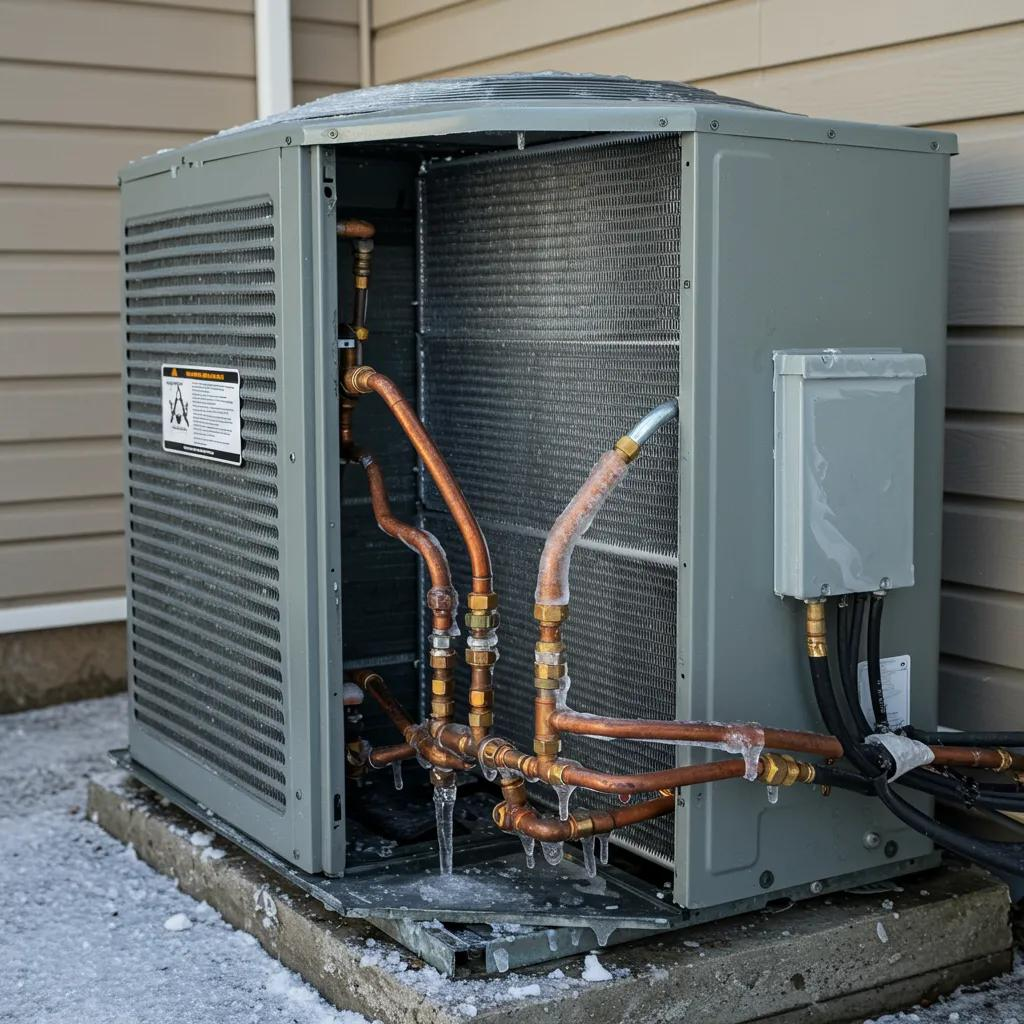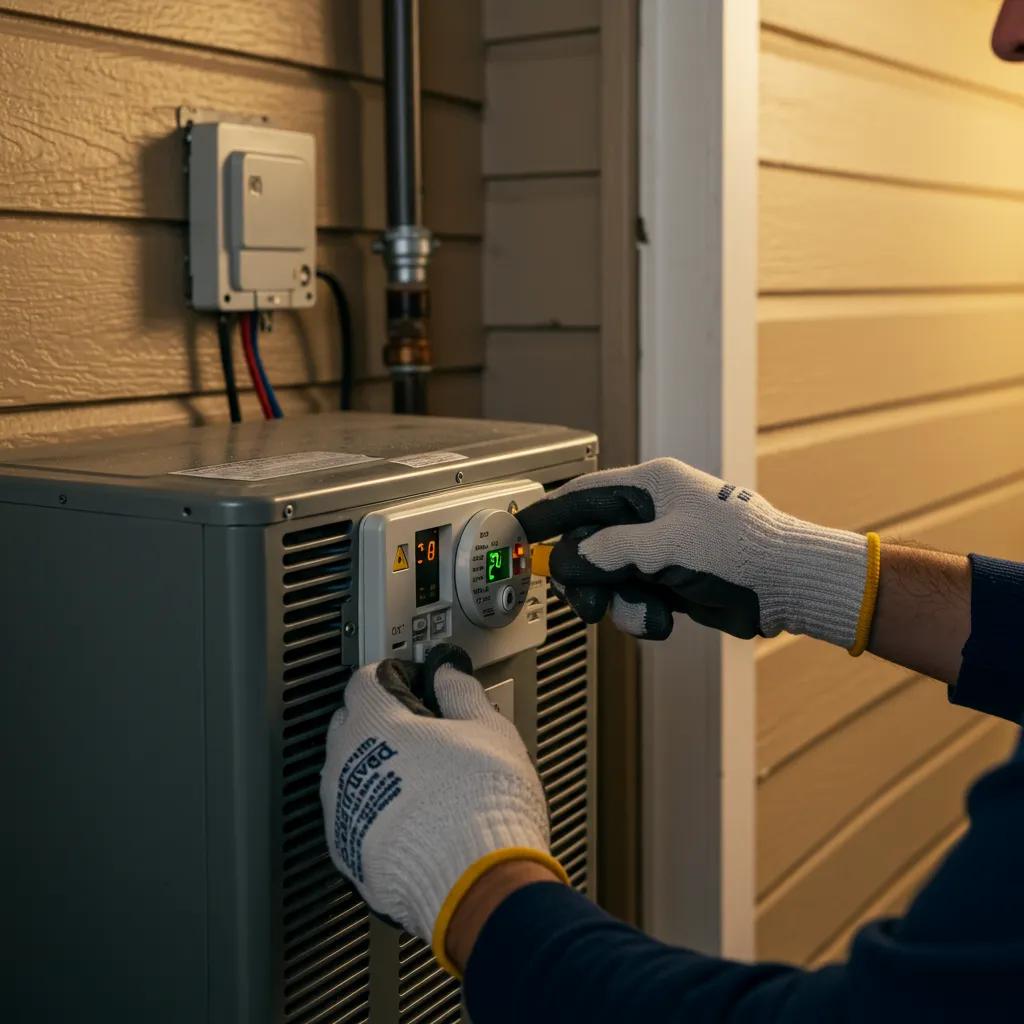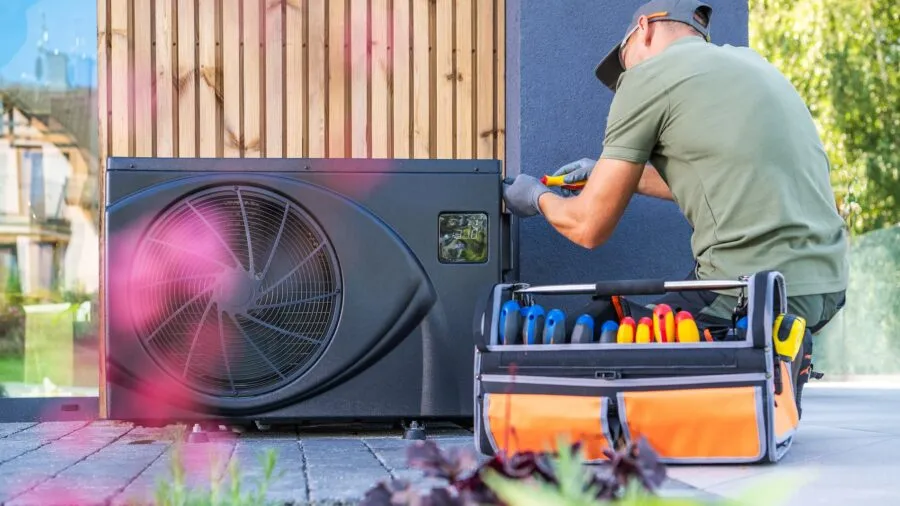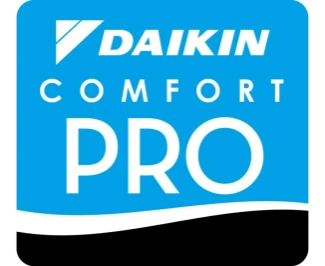HVAC System Frozen? Troubleshooting Guide

HVAC System Frozen? Troubleshooting Guide for Defrosting and Repair
When your HVAC system freezes, you'll see ice or frost on components like the evaporator coil, refrigerant lines, or drain pan. This ice blocks proper heat exchange, leading to weaker cooling, potential water damage, and strain on your compressor. This guide will walk you through why freezing happens, safe steps to melt the ice, how to pinpoint the cause, and ways to prevent it from happening again. You'll learn practical DIY defrosting techniques, how to interpret system sounds and visual cues, and when it's time to call in the pros. We've included clear how-to instructions, a checklist of common causes, diagnostic tables to help you narrow down issues, specific advice for furnaces, and guidance on when professional repair or emergency service is necessary. We've also integrated keywords like "HVAC frozen," "AC frozen," "frozen evaporator coil," "blocked condensate drain line," and "refrigerant leak ice buildup" to help you find the right solutions and communicate effectively with technicians.
What Are the Immediate Steps to Take When Your HVAC System Freezes?
When your HVAC system freezes, the first crucial steps involve shutting down the cooling cycle and circulating air to safely melt the ice. This prevents further damage to your compressor and allows you to inspect the unit. Turning off your thermostat and cutting power at the breaker stops the system from working harder, while setting the fan to "ON" circulates room air to speed up defrosting. These initial actions protect your equipment and give you time to assess the situation. Next, we'll cover safe power-down procedures, explain why the fan-only setting is so effective, and set realistic expectations for defrosting times.
How Do You Safely Turn Off and Defrost a Frozen HVAC Unit?

To safely power down a frozen system, start by turning off your thermostat. Then, locate the outdoor unit's disconnect switch or the main house breaker for your HVAC system and switch it off to completely cut power. Once the compressor is off, set your indoor thermostat's fan to "ON." This circulates room air over the frozen evaporator coil, helping the ice melt naturally. Never try to force the ice off with sharp objects, as this can easily damage the delicate fins and refrigerant lines. Place towels or a shallow pan beneath your indoor unit to catch any melting water. Carefully check the condensate drain line for blockages and clear any standing water while wearing gloves. Allow several hours for passive defrosting. If ice remains or water has contacted any wiring, keep the system powered off and proceed to professional diagnosis to avoid electrical or refrigerant hazards.
Why Should You Run the Fan Only During Defrosting?
Running your system in fan-only mode is key to defrosting because it circulates warmer indoor air over the frozen evaporator coil. This gentle heat transfer accelerates melting without engaging the compressor, which could worsen the icing if the underlying issue isn't resolved. The fan-only approach relies on convection to restore normal coil temperatures. It also helps to dry out the surrounding ductwork and reduces the amount of meltwater collecting in the drain pan. Understanding this process highlights why the fan is your most important DIY tool during a freeze-up and sets the stage for discussing how long defrosting typically takes and when passive methods are sufficient.
How Long Does It Take to Defrost an AC or Furnace Coil?
Typically, passive defrosting takes anywhere from two to eight hours, depending on how thick the ice is, the indoor temperature, and how much air is circulating. Light frost might disappear in a couple of hours, but heavy ice buildup could take most of the day. Factors like a very cold indoor environment, blocked vents, or outdoor temperatures near freezing can extend these times. If you don't see improvement, it's a sign you might need professional help. You'll know defrosting is working when you see liquid water draining from the coil, airflow returns to normal, and no new ice forms after you briefly turn the compressor back on to test. If ice reappears within 24 hours of restarting, turn the system off and call a technician, as persistent refreezing often points to low refrigerant, airflow blockages, or mechanical failures.
What Are the Common Causes of a Frozen AC or HVAC System?
The most common reasons your HVAC system might freeze up fall into three main categories: restricted airflow, refrigeration problems, and drainage issues. Each of these can cause the evaporator coil to get too cold or prevent meltwater from draining properly, leading to ice formation. Restricted airflow, often due to dirty filters or closed vents, means not enough warm air is passing over the coil. Low refrigerant levels can cause the coil pressure and temperature to drop too low. Blocked condensate drains allow water to pool and freeze. Identifying the specific cause helps you determine the best DIY fixes or when to call for professional service. The following list and table compare these causes, explain how they lead to freezing, and suggest quick checks you can perform.
Here are the primary culprits behind a frozen HVAC system:
- A dirty air filter that restricts airflow, causing the coil temperature to plummet and moisture to freeze.
- Low refrigerant levels, which reduce system pressure and coil temperature, leading to frost on lines and coils.
- A blocked condensate drain line, causing water to back up and freeze in the drain pan or near the coils.
This brief list covers the main causes. The table below offers immediate checks and actions to help you validate each one.
Different freezing causes present distinct symptoms. Use this table to match a likely cause with a quick DIY check.
Use these comparisons to prioritize safe DIY checks, then move into the diagnostic process to narrow down the specific cause.
How Can You Diagnose the Specific Cause of Your Frozen HVAC System?
Diagnosing why your HVAC system froze involves matching visual clues, airflow readings, and operational sounds to potential root causes. This helps you take the right corrective actions. For instance, where the ice is located—on the evaporator coil, refrigerant lines, or drain pan—can point towards refrigerant or airflow issues. Checking airflow at your vents and inspecting the filter can reveal obstructions. Unusual sounds like hissing or rapid cycling might suggest leaks or electrical control problems. Below, we outline targeted visual and operational checks, along with a diagnostic table to help you connect symptoms to likely causes and recommended next steps.
What Visual Signs Indicate the Source of Freezing?
Ice forming on the evaporator coil often signals an airflow problem or low refrigerant. Ice on the refrigerant lines themselves usually points to refrigerant-related pressure issues. If ice is primarily in the drain pan or near the condensate line, it likely indicates a drainage blockage. Always turn off the power before inspecting the indoor air handler. Look closely at where the frost is located and how thick it is. Thin, white frost along the coil edges is different from thick, opaque ice that bridges components. Also, check for water stains below the unit, which suggest melting and potential overflow. Understanding these visual cues will guide your next steps in checking airflow and listening for sounds to confirm the cause.
How Do You Check Vents, Registers, and Airflow Issues?
Start by making sure all your supply and return vents are open and nothing is blocking them. Then, when the fan is running, feel each register to ensure you have steady airflow. Weak or absent airflow suggests a problem with the filter, the blower motor, or restrictions within the ductwork. Pull out your air filter and check if it's dirty; if you have a thermometer, compare the temperature of the air coming from your supply vents to the air returning to the unit. A small temperature difference combined with low airflow strongly supports the idea of an airflow restriction. If you can safely access the blower compartment with the power off, visually inspect the blower wheel for excessive dust buildup, which can significantly reduce airflow.
When Should You Call a Professional HVAC Technician for a Frozen System?
Knowing when to call a professional is crucial for your safety and to prevent making the problem worse. Technicians have the specialized tools and expertise to handle refrigerant, electrical, and complex mechanical issues safely. You should call a licensed technician if you suspect a refrigerant leak, notice electrical smells or see exposed wiring, experience persistent refreezing after defrosting, or suspect issues with the compressor or control board. Below, we provide clear examples of complex problems, a checklist to help you decide if DIY defrosting is insufficient, and a list of urgent safety concerns that require immediate professional attention. Following these guidelines, we'll discuss specific complex repairs and signs that indicate a technician is needed, as well as highlight local emergency service availability for urgent situations.
What Complex Issues Require Expert Repair?
Complex issues that demand a certified technician include detecting and recharging refrigerant leaks, diagnosing compressor failures, replacing electrical components, and performing sealed-system pressure tests. These tasks require specialized equipment and adherence to strict regulations. Handling refrigerant is hazardous and regulated; technicians use advanced gauges, leak detectors, and recovery systems to safely diagnose and fix pressure-related freezing causes. Electrical diagnostics for control boards and contactors also require trained professionals to prevent shock and fire hazards while ensuring reliable operation. Because these repairs directly impact system safety and longevity, engaging a professional guarantees correct repairs and minimizes the risk of recurring freezing.
How Do You Know If DIY Defrosting Isn’t Enough?
Your DIY defrosting efforts might not be enough if ice keeps returning within 24 hours, if airflow remains weak even after checking filters and vents, or if the unit simply doesn't cool effectively once thawed. If passive defrosting and simple fixes like changing filters or clearing drains don't restore normal operation within a day, it's time to escalate to professional diagnostics. Other warning signs include persistent abnormal sounds after thawing, visible oil on refrigerant lines (indicating a leak), or electrical smells during startup. Any of these situations warrant technician intervention. Use this checklist to confidently move from DIY troubleshooting to professional repair.
- If ice reappears within 24 hours after defrosting, it's time to call a technician.
- If airflow doesn't improve after checking filters and vents, schedule professional service.
- If you detect hissing, oil residue, or electrical smells, shut down the system immediately and seek professional repair.
What Safety Concerns Warrant Immediate Professional Help?
Immediate professional help is essential for issues like electrical burning smells, exposed wiring near water sources, refrigerant fumes, or water coming into contact with electrical components. These are serious hazards that can lead to fires or health risks. If you notice any of these signs, shut off the HVAC system at the breaker, avoid touching any wet electrical parts, and arrange for emergency assistance. In urgent freeze situations where property damage is imminent—such as continuous water overflowing into living spaces or critical equipment areas—rapid response is vital to minimize loss. Top Shelf Heating and Air, Inc. offers 24/7 emergency service and local expert availability throughout Ventura County to address these urgent situations and protect your home or business.
How Can You Prevent Your HVAC System from Freezing in the Future?

Preventing future freezing boils down to consistent maintenance that ensures proper airflow, correct refrigerant levels, and clear condensate drainage. These actions keep your evaporator coil operating within its normal temperature range. A proactive maintenance plan includes regularly replacing filters, cleaning coils and blowers, inspecting condensate lines, and having certified technicians perform periodic refrigerant checks. Below, we outline recommended routine tasks, a maintenance schedule table, and seasonal tips specifically for Ventura County homes to help you reduce freeze risks through simple, recurring actions. After the maintenance checklist, we'll delve into airflow strategies, the importance of refrigerant servicing, and local seasonal considerations.
What Regular Maintenance Helps Avoid Frozen AC Coils?
Regular maintenance is your best defense against frozen AC coils. This includes replacing or cleaning your air filters every 1–3 months, depending on usage and indoor air quality. It also involves cleaning the evaporator coils annually and checking the blower's performance to ensure it's moving the correct amount of air (CFM) across the coil. A clean filter restores proper airflow, a clean coil improves heat transfer, and a well-functioning blower ensures adequate air velocity to prevent coil temperatures from dropping below freezing. Schedule professional tune-ups before the peak cooling season and after extended periods of inactivity to catch any early refrigerant or mechanical issues. These routines significantly reduce the likelihood of frozen evaporator coils, extend your equipment's lifespan, and improve your indoor air quality.
This schedule helps prioritize simple actions that materially reduce freezing risk and guides when to involve professional maintenance services.
How Does Ensuring Proper Airflow Prevent Ice Buildup?
Maintaining proper airflow is critical because it ensures that warm return air continuously removes heat from the evaporator coil, keeping its temperature above freezing. When airflow is insufficient, the coil's surface can drop below 0°C (32°F), causing condensed moisture to freeze. Simple steps you can take include keeping your filters clean, ensuring all registers and return vents are open and unobstructed, and checking your ducts for significant leaks or collapsed sections that reduce airflow. If DIY measures aren't enough, professional ductwork repair or blower servicing can restore the designed airflow volumes and balance your system. Ensuring adequate airflow not only prevents ice buildup but also enhances indoor comfort and energy efficiency.
Why Is Timely Refrigerant Service Important for Freeze Prevention?
The correct refrigerant charge is essential for your evaporator coil to operate at its intended pressure and temperature. If the refrigerant level is low or the refrigerant is contaminated, it can lower the coil's pressure and cause freezing on the lines and coils. Since handling refrigerant involves environmental regulations, requires certification, and necessitates specialized equipment, any leak repairs, recovery, or recharging should be performed by certified technicians who adhere to regulatory standards. Timely refrigerant service prevents the chronic low-pressure conditions that lead to freezing symptoms and protects your compressor by restoring optimal operating conditions. Recognizing signs like ice on refrigerant lines, reduced cooling performance, and abnormal system pressures should prompt a refrigerant check rather than extended DIY attempts.
What Seasonal Tips Are Recommended for Ventura County Homes?
Given Ventura County's climate, pre-summer checks are particularly important to prevent freezing issues that can arise after long periods of inactivity or sudden humidity changes. Schedule your system's maintenance before the peak cooling season to ensure your filtration, coils, and drainage systems are in top condition. During transitional seasons, run your system periodically to circulate air, check the condensate trap for pooling, and replace filters after any high-dust events common in the area. For homes with mini-splits or heat pumps, make sure the outdoor units are clear of debris and vegetation that could restrict airflow. These seasonal practices reduce the likelihood of freeze events while aligning maintenance with local climatic demands.
Conclusion
Understanding how to troubleshoot a frozen HVAC system empowers homeowners to take immediate action and prevent further damage. By following the outlined steps and recognizing when to seek professional help, you can ensure your system operates efficiently and safely. Regular maintenance and awareness of common issues will help you avoid future freezing incidents. For expert assistance or to schedule a maintenance check, contact Top Shelf Heating and Air, Inc. today.
Customer Testimonials
Blogs







.jpg)